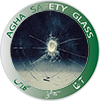Bullet Resistant Glass: How Is It Made?
Plastic itself is not bullet resistant, but when put in between layers of glass, it deforms and absorbs the bullet’s energy and thus helps in preventing it from penetrating the glass – stooping it before it goes out the other side.
In order to withstand the massive force bullets can confer on it, bullet resistant glass has gone through an evolution of different materials and methods for the purpose of perfecting it. It is most commonly made of laminated glass arranged in layers, thermoplastic and Chemical. The Chemical or plastic are layered between sheets of standard glass; this process is called lamination.
The challenge in constructing bullet resistant glass is to make it as transparent and clear as regular glass while stilllensuring that its protective qualities are effective. Bullet resistant glass made with Chemical usually incorporates types of Chemical sheets such as Lexon, Tuffak, Makroclear, etc. between layers of standard glass. However, the glass itself also undergoes processes to make it stronger, namely, tempering. In tempering, the glass undergoes chemical processes or is treated with cooling and heating that strengthen it.
Plastic also serves as a key material in bullet resistant glass. Plastic itself is not bullet resistant, but when put in between layers of glass, it deforms and absorbs the bullet’s energy and thus helps in preventing it from penetrating the glass – stooping it before it goes out the other side. Other materials used in the making of bullet resistant glass are ethylene vinyl acetate, polyvinyl butyral and polyurethane. Bullet resistant glass made with these materials is usually used in military vehicles and tends to be very thick and heavy.
The Properties of Bullet Resistant Glass



